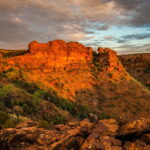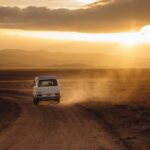Central Queensland is home to an abundance of awe-inspiring natural wonders, leaving both nature and adventure lovers spoilt for choice.
For those who prefer to have a pocket-friendly adventure during your trip to Central Queensland, you will be pleased to know that there are plenty of spectacular national parks to visit. These visits are free of charge, and you can even camp in some of these national parks for a small fee.
Let’s look at some of the tips and tricks on how to fully experience the National Parks of Central Queensland.
1. VISIT DURING OFF PEAK TIMES
Nature is best appreciated in peace and quiet.
To avoid getting disappointed by the human or car beeline when visiting one of the country’s beautiful national parks, plan for your trip to happen at off peak season. Peak seasons are school holidays, national holidays, summer, weekends, and so on.
With the crowds, it can be difficult to fully enjoy the fantastic spots. In fact, you may be pleasantly surprised by what you may encounter when seeking solitude during off peak times. Sure, the colder temperatures of winter can be uncomfortable, but all you need to do it gear up your attire and you will get to witness the magical ambience that the wintry light cast upon the mountains and deserts.
Not to mention, travelling during off peak times makes you pay lesser for flights, accommodation and transportation, along with a myriad of other benefits.
2. WEAR THE RIGHT ATTIRE
Central Queensland is a true outdoor gallery for interesting rock formations. Minerva Hills National Park, for example, has spectacular jagged peaks.
With a hike to Skyline Lookout, you get to see the iconic Virgin Rock on Mount Zamia. The Virgin Rock derived its name from the figure that looks like Virgin Mary cradling the baby Jesus. For an even more majestic experience, visit the Skyline Lookout at night when it is floodlit.
Regardless of where you go, you will have to look out for what season it is. Depending on which season you would like to visit it, you will need to gear up properly as the trails can be rocky and steep. The usual items to prepare yourself with include hiking boots or sports shoes, sunscreen, a long sleeve top (light one for summer to prevent sunburn and a thicker one for winter to brave the chill) and a hat.
To give you an idea, camping in Minerva Hills National Park is not allowed, so staying nearby in Emerald is an excellent choice. And before you go, don’t forget to stock up your energy at a local hub like the Maraboon Tavern, a local pub in Emerald that boasts excellent local food.
3. GO WITH A PLAN
As exciting as an unplanned trip can be, visiting national parks in Central Queensland fall under the category of places you would explore better with a plan intact. This is especially so if you plan on visiting a sprawling national park, such as Carnarvon National Park with its massive ground coverage.
Deciding on a plan can be overwhelming, and you may find yourself flustered on where to start. As a tip, don’t try to squeeze all the historic landmarks and fantastic landscape into your itinerary, especially if your trip is short.
Not only will you most likely not see it all, but you’ll also quickly (and easily) turn your relaxing trip to a stressful disaster.
Instead, pick one or two things you would want to accomplish on your trip that is reasonable based on the amount of time you have. Take into consideration distances between each landmark, rest times, as well as delays to compensate for any loss in travel time.
Once you have achieved your objective, you can do offshoots on your way back if you have excess time on your hands.
4. GO CAMPING
While not every national park in Central Queensland allows camping, you should definitely take advantage of those that do allow it.
The ultimate enjoyment of visiting a national park is to camp under the stars even if it is just for a night or two. What makes camping so special and memorable is that when you are out in the wild, you are forced to connect not only with nature but also with the people around you.
To name a few things, we recommend packing a tent, sleeping bag and pad, lighters, flashlights and a water filter. Be sure to call ahead to check on the availability period of camping. You should also enquire about any extra equipment you will need and make an effort to book your spot in advance to avoid any disappointments.
5. DO YOUR RESEARCH
Although flexibility should be part of your plan, doing your research beforehand will help save a lot of your time.
You will find plenty of information available online, including maps, trails, hours, restrictions, and so on, on almost all of the national parks in Central Queensland.
Be sure to check the official websites for all the necessary information. You definitely won’t want to waste time at the visitor centre staring at a map for the first time or risk getting lost in the middle of a trail, especially if your time is limited.
As you travel deep inside a national park, Wi-Fi can be spotty in some areas, so it is always wise to bring the good old maps and guidebooks on your trip. A quick tip here for those who travel with their pets – the Queensland Government states that dogs and other pets are welcome in some conservation parks and recreation areas but not in national parks to protect the native plants and animals or there may be fines applicable.
6. RESPECT NATURE
Nature is beautiful yet sensitive at the same time.
Although some pictures are more Instagram-able if taken up close, know that you may also be running the risk of damaging the ecosystem when going off the trails.
You don’t need to leave behind evidence that you were at a national park by doing silly things like carving your initials onto the rocks. Be respectful of the national parks in helping to preserve its sanctity for decades to come.
Lastly, littering is just a selfish act that spreads germs to the animals, which eventually become carriers for diseases and cause pollution to the environment. Smoking is also prohibited in many areas of the national parks. Not only is it a fire hazard, but it is also rude and disrespectful to the land and the people around you.
The national parks provide a much-needed refuge for plants and wild animals. It is our privilege to be able to preserve it and experience it, especially when it is at its best prime condition – unpolluted and loved.



